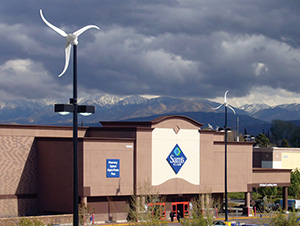How Walmart’s ‘Project Gigaton’ is saving emissions — and saving along the company’s bottom line.
Interview by Katie Lee
When it comes to corporate responsibility to the environment, Walmart is an undisputed leader in its commitment and vast global impact. ‘Project Gigaton’ — Walmart’s signature program to reduce greenhouse gas emissions by one gigaton — is no exception. Only 1 year into the program, Walmart is exceeding expectations and, additionally, plans to more than double the renewable energy it uses in the U.S. via new solar and wind projects, with a 2025 goal to power half of its operations from renewable sources. Walmart also plans to double the number of electric vehicle (EV) charging stations, making it one of the largest EV charging station hosts in the country. Below is a Q&A with Walmart’s senior vice president of global sustainability, Laura Phillips.
R&R: With almost 12,000 stores worldwide, Walmart’s impact from a sustainability standpoint can be seismic. Please tell me about Project Gigaton and your latest plans regarding renewable energy sources and EV charging stations.
 Laura Phillips: We launched Project Gigaton in April 2017 as part of a series of sustainability initiatives focused on addressing social and environmental issues — and we’re encouraged by the progress we’ve seen so far. On a goal to reduce emissions one gigaton (a billion metric tons) by 2030, to date, more than 400 suppliers with operations in more than 30 countries have joined the program and have reported avoiding more than 20 million metric tons (MMT) of greenhouse gas emissions (as of April 2018). When joining Project Gigaton, suppliers can commit to reductions in any of six pillars that include energy, agriculture, waste, packaging, deforestation and product use and consult our Walmart Sustainability Hub for resources and contacts for help in each of the pillars as well as assistance on how to get started.
Laura Phillips: We launched Project Gigaton in April 2017 as part of a series of sustainability initiatives focused on addressing social and environmental issues — and we’re encouraged by the progress we’ve seen so far. On a goal to reduce emissions one gigaton (a billion metric tons) by 2030, to date, more than 400 suppliers with operations in more than 30 countries have joined the program and have reported avoiding more than 20 million metric tons (MMT) of greenhouse gas emissions (as of April 2018). When joining Project Gigaton, suppliers can commit to reductions in any of six pillars that include energy, agriculture, waste, packaging, deforestation and product use and consult our Walmart Sustainability Hub for resources and contacts for help in each of the pillars as well as assistance on how to get started.
Walmart also launched Project Gigaton in the UK and China this year, setting a China specific goal of 50MMT of emissions avoided.
Regarding renewable energy, we are moving closer toward our 2025 goal of being supplied globally with 50% renewable energy thanks to several new solar and wind projects underway. We plan to more than double the amount of renewable energy we use in the U.S. and increase the percentage of global electricity needs supplied by renewable sources above our current rate of approximately 28%.
We’re also excited about expanding the availability of electric vehicle (EV) charging stations at our stores in 34 states. The ultra-fast charging systems will provide our customers with a quick and convenient way to charge their vehicles. This expansion will bring Walmart’s total number of EV charging units to well over 1,000 when complete, making us one of the nation’s leading EV charging station hosts and creating a national grid of EV charging availability at hundreds of Walmart stores and Sam’s Clubs locations.
R&R: How did Project Gigaton come about?
 Phillips: Greenhouse gas (GHG) emissions are the leading contributor to the rapid rise of global temperatures and climate change. With 90% of Walmart’s total GHG emissions coming from our supply chain, we knew we could — and should — do more to avoid emissions.
Phillips: Greenhouse gas (GHG) emissions are the leading contributor to the rapid rise of global temperatures and climate change. With 90% of Walmart’s total GHG emissions coming from our supply chain, we knew we could — and should — do more to avoid emissions.
Walmart is the first retailer to establish a verified, science-based target (SBT) emissions reduction plan. Project Gigaton falls under the approved plan, avoiding emissions from upstream and downstream by one billion tons (a gigaton) between 2015 and 2030. Additionally, the company aims to reduce its absolute scope 1 and 2 emissions from its operations 18% by 2025. The Science Based Targets initiative is a partnership between CDP, UN Global Compact, World Resources Institute and World Wildlife Fund to help companies determine how much they must cut emissions to prevent the worst impacts of climate change.
Walmart’s commitment to reduce emissions is a contribution to bold, collective action and is made in line with the level of decarbonization required to keep global temperature increase below 2 degrees Celsius compared to pre-industrial temperature levels, in line with the Paris Climate Agreement.
R&R: How do you put that number — one gigaton — in perspective?
Phillips: Avoiding one gigaton of emissions is equivalent to removing 211 million passenger vehicles from the road for a year, per the Environmental Protection Agency’s greenhouse gas equivalency calculator, or, the emissions generated in Germany for 1 year.
There are one billion metric tons in one gigaton. For perspective, one gigaton is equal in weight to over 6 million blue whales. For volume, one gigaton equals 222 million Olympic swimming pools full of CO2. (Olympic size pools are 2,500m³.)
R&R: The success of Project Gigaton has exceeded expectations, correct?
 Phillips: As of April 2018, more than 400 suppliers had joined the program, and have avoided more than 20 million metric tons of greenhouse gas emissions. We think this is a strong start, and we have high hopes that we will not only see the overall supplier count rise, but that we’ll also increasingly see the ambition of these goals get bigger and bigger.
Phillips: As of April 2018, more than 400 suppliers had joined the program, and have avoided more than 20 million metric tons of greenhouse gas emissions. We think this is a strong start, and we have high hopes that we will not only see the overall supplier count rise, but that we’ll also increasingly see the ambition of these goals get bigger and bigger.
R&R: What does this mean for your next steps?
Phillips: We feel good about the pipeline of suppliers engaged in Project Gigaton to date, and we plan to engage more. We’re encouraging all suppliers to set specific and measurable targets, which will start reporting back further impact in the years to come.
Working towards a goal like this, and to contribute to the broader issues, will take all of us coming together making commitments to move the needle forward.
R&R: You anticipate more of your suppliers will set science-based targets and goals?
Phillips: We are hopeful that more suppliers will set science-based targets; currently, a number of suppliers participating in Project Gigaton have science-based targets approved by the Science-Based Targets Initiative.
While suppliers setting science-based targets are without question leading the way, we’re encouraging all suppliers to get started, wherever they are in their journey, by setting a smart goal, big or small.
R&R: Do you want to name some of the suppliers making some of the biggest changes? Such as Procter & Gamble?
Phillips: One of the largest commitments this year came from Procter & Gamble with their commitment to avoid 50 million metric tons (MMT) of emissions from their operations and value chain by 2030. They plan to achieve this by inviting customers to join the Tide #QuickColdPledge, switching to quick and cold laundry cycles that use less water, 80% less energy and create 40% fewer emissions in every load. They also made the impressive commitment to source 100% renewable electricity in their North American operations by 2020.
R&R: How do sustainability plans factor into new builds?
Phillips: Walmart plans to open a mix of Neighborhood Market stores and Supercenters this year. We incorporate sustainable building practices into many of our new stores, including the design and installation of efficient technology such as high-efficiency rooftop heating and cooling units, LED lighting technology and solar panels.
R&R: What percentage of your fleet is being retrofitted to be more environmentally friendly?
Phillips: Walmart is one of the leading U.S. companies for number of locations utilizing on-site solar energy and we plan to add an additional 130 sites, which will bring our total to approximately 500 locations across 22 U.S. states and Puerto Rico, surpassing our 2014 goal to double our onsite solar use by 2020.
Regarding our fleet, our fleet team and vendors are focused on efficiency and reducing environmental impacts by improving techniques for loading, routing and driving. In fact, in 2015, we announced that we had exceeded our goal of doubling the efficiency of our trucking fleet. This achievement was made possible in multiple ways, including effective driving techniques, tractor trailer technologies, improved processes and systems to ensure efficient loading and routing of merchandise and more. With these new efficiencies, we saved nearly $1 billion and avoided nearly 650,000 metric tons of CO2 emissions compared to our 2005 baseline.
R&R: When your electric vehicle charging expansion is complete, Walmart will be one of the largest EV charging station hosts in the country. Did you anticipate that, and do you think other retailers will follow your lead?
Phillips: We are excited about our ability to be able to offer to this option to more of our customers and in areas where this technology is not as easily accessible.
It’s always our hope that our sustainability initiatives inspire others to take action or make changes in their own businesses that benefit the environment.
R&R: What advice do you have for retailers, with multiple locations and on a mass scale, who want to be more sustainable but aren’t sure where to start?
Phillips: Through our journey, our eyes have been opened to a few key trends that have contributed to some of our sustainability success.
 To begin with, we quickly discovered that we can’t create a solution on our own. Driving meaningful change requires collaboration — from convening environmental NGO partners to working with suppliers to create more efficient supply chains and even joining forces with competitors to create solutions to shared problems. To gain a true systems change, we must all work together to identify the root of major problems.
To begin with, we quickly discovered that we can’t create a solution on our own. Driving meaningful change requires collaboration — from convening environmental NGO partners to working with suppliers to create more efficient supply chains and even joining forces with competitors to create solutions to shared problems. To gain a true systems change, we must all work together to identify the root of major problems.
Additionally, we have found that sustainability makes good business sense. Walmart has been able to incorporate technologies and developments within our supply chain — from energy efficiency to reducing food waste — that have not only reduced our environmental impact, but also saved us money as a company.
And lastly and perhaps most importantly, customers want to buy products they feel good about. In embarking on our sustainability journey, we quickly came to realize that people want to feel good about the products they buy.
R&R: With whom are you working on the EV charging station expansion?
Phillips: We are working with Electrify America. They’re installing charging systems that will create a more resourceful and enjoyable one-stop retail experience for our customers, allowing them to charge their vehicles as they shop.
R&R: Are most states offering incentives, or are you still seeing better incentives abroad than at home?
Phillips: In some markets, our renewable energy projects are viable without government incentives; however, in many regions, government incentives can help make the project viable.
R&R: Walmart hopes to be supplied globally with 50% renewable energy by 2025. Are you on target?
Phillips: Walmart is making progress in our renewable energy efforts that will move us closer toward our 2025 goal of being supplied globally with 50% renewable energy. As a result of several new solar and wind projects, Walmart plans to more than double the amount of renewable energy we use in the U.S. and increase the percentage of global electricity needs supplied by renewable sources above the current 28%.
R&R: With whom are you working with on renewable wind energy projects? Do you run into different processes, incentives and rebates state by state?
Phillips: We’re working with a variety of entities such as Akou Energy, Geronimo Energy, Engie and others on our wind energy efforts.
Regulations do vary from state to state, which is why we advocate for increased access to renewable energy sources. Increased access to wind, solar and other renewable resources can help ensure that renewable technologies have sufficient efficiencies and operating potential.
R&R: What are your biggest operational and/or maintenance related challenges associated with the new sustainability measures?
Phillips: When it comes to our 2025 goal to power half our operations from renewable sources, one of our biggest challenges as a large-scale energy buyer is getting access to more renewable energy in more places. That’s why we’re working with other major companies to boost global demand for renewable energy, accelerate innovation and make renewable energy technologies more affordable as signatories to the Renewable Energy Buyers Principles and through our membership to the global RE100.
R&R: What do you think is unique about your commitment to corporate sustainability as compared to other retailers?
Phillips: The scale of our Project Gigaton commitment makes it one of the more unique projects in corporate sustainability and the fact that we are working with organizations like WWF and EDF to develop very detailed methodology to help suppliers quantify their changes is significant.
Walmart also stands out as we were the first retailer to set an emissions-avoidance plan approved by the Science Based Targets Initiative, in alignment with the Paris Climate Agreement. My team worked for more than a year to formulate and get approval for our plan in late 2016, which consists of the following targets:
- Reduce our absolute scope 1 and 2 emissions 18% by 2025, from 2015 levels.
- Work with suppliers to reduce greenhouse gas emissions from upstream and downstream scope 3 sources by one billion tons (1 gigaton) between 2015 and 2030 (also known as Project Gigaton).
R&R: What do you enjoy most about your job on a daily basis?
Phillips: I love being in a position where I get to work with organizations up and down the entire industry — from Walmart associates to suppliers to NGOs. I’m very proud of all the accomplishments that are made when people come together to create systems change, and it is exciting to be a part of those global efforts.
For example, to date an estimated 78% of our global waste has been successfully diverted from landfill, we’re operating on an estimated 28% renewable energy (tracking toward our goal to be powered by 50% renewable energy by 2025), and we’re working to make our product mix more sustainable. We couldn’t have made these impacts without many people coming together to work through barriers, drive innovation and move quickly.
R&R: What are some future goals you’ve set for your team?
Phillips: My team is always looking for what’s next, while staying focused on the measurable goals we’ve set for ourselves. In late 2016, our company set new goals to help us track toward our larger sustainability aspirations of using renewable energy, producing zero waste and selling sustainable products. Our company is working towards those new goals with a target achievement date of 2025, including:
- Powering half of our operations from renewable sources;
- Achieving zero waste to landfill in our operations in four key markets;
- Moving our Walmart U.S. private brand products to 100% recyclable packaging; and
- Expanding and enhancing sustainable sourcing to cover 20 key commodities.
We are making steady progress, and my priority is continuing to move the needle forward towards a sustainable company and a more sustainable world.
— This article originally appeared as the cover story of the August 2018 issue of Retail & Restaurant Facility Business magazine. Email the editor, Katie Lee, at [email protected].
